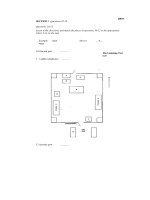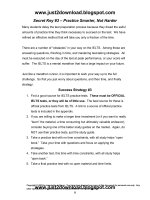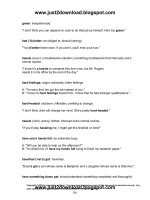Ielts sure success 8 ppsx
Bạn đang xem bản rút gọn của tài liệu. Xem và tải ngay bản đầy đủ của tài liệu tại đây (95.37 KB, 6 trang )
28
Copyright © 2003 by Linguistics at Nicon. You have been licensed one copy of this document for personal use only. Any
other reproduction or redistribution is strictly prohibited. All rights reserved.
issue, different groups are impacted, with many reaching the same conclusion or
position, but through vastly different paths. Try to “see” the issue through as
many different eyes as you can. Look at it from every angle and from every
vantage point. The more diverse the reasoning used, the more balanced the
paper will become and the better the score.
Example:
The issue of free trade is not just two sided. It impacts politicians, domestic (US)
manufacturers, foreign manufacturers, the US economy, the world economy,
strategic alliances, retailers, wholesalers, consumers, unions, workers, and the
exchange of more than just goods, but also of ideas, beliefs, and cultures. The
more of these angles that you can approach the issue from, the more solid your
reasoning and the stronger your position.
Furthermore, don’t just use information as to how the issue impacts other people.
Draw liberally from your own experience and your own observations. Explain a
personal experience that you have had and your own emotions from that
moment. Anything that you’ve seen in your community or observed in society
can be expanded upon to further round out your position on the issue.
Pick a Main Idea
Once you have finished with your creative flow, stop and review it. Which idea
were you able to come up with the most supporting information? It’s extremely
important that you pick an angle that will allow you to have a thorough and
comprehensive coverage of the topic or table. This is not about your personal
convictions, but about writing a concise rational discussion of an idea.
Weed the Garden
Every garden of ideas gets weeds in it. The ideas that you brainstormed over
are going to be random pieces of information of mixed value. Go through it
methodically and pick out the ones that are the best. The best ideas are strong
points that it will be easy to write a few sentences or a paragraph about.
29
Copyright © 2003 by Linguistics at Nicon. You have been licensed one copy of this document for personal use only. Any
other reproduction or redistribution is strictly prohibited. All rights reserved.
Create a Logical Flow
Now that you know which ideas you are going to use and focus upon, organize
them. Put your writing points in a logical order. You have your main ideas that
you will focus on, and must align them in a sequence that will flow in a smooth,
sensible path from point to point, so that the reader will go smoothly from one
idea to the next in a logical path. Readers must have a sense of continuity as
they read your paper. You don’t want to have a paper that rambles back and
forth.
Start Your Engines
You have a logical flow of main ideas with which to start writing. Begin
expanding on the issues in the sequence that you have set for yourself. Pace
yourself. Don’t spend too much time on any one of the ideas that you are
expanding upon. You want to have time for all of them. Make sure you watch
your time. If you have twenty minutes left to write out your ideas and you have
ten ideas, then you can only use two minutes per idea. It can be a daunting task
to cram a lot of information down in words in a short amount of time, but if you
pace yourself, you can get through it all. If you find that you are falling behind,
speed up. Move through each idea more quickly, spending less time to expand
upon the idea in order to catch back up.
Once you finish expanding on each idea, go back to your brainstorming session
up above, where you wrote out your ideas. Go ahead and erase the ideas as
you write about them. This will let you see what you need to write about next,
and also allow you to pace yourself and see what you have left to cover.
First Paragraph
Your first paragraph should have several easily identifiable features.
First, it should have a quick description or paraphrasing of the topic or table. Use
your own words to briefly explain what the topic or table is about.
30
Copyright © 2003 by Linguistics at Nicon. You have been licensed one copy of this document for personal use only. Any
other reproduction or redistribution is strictly prohibited. All rights reserved.
Second, you should explain your opinion of the topic or table and give an
explanation of why you feel that way. What is your decision or conclusion on the
topic or table?
Third, you should list your “writing points”. What are the main ideas that you
came up with earlier? This is your opportunity to outline the rest of your paper.
Have a sentence explaining each idea that you will go intend further depth in
additional paragraphs. If someone was to only read this paragraph, they should
be able to get an “executive summary” of the entire paper.
Body Paragraph
Each of your successive paragraphs should expand upon one of the points listed
in the main paragraph. Use your personal experience and knowledge to support
each of your points. Examples should back up everything.
Conclusion Paragraph
Once you have finished expanding upon each of your main points, wrap it up.
Summarize what you have said and covered in a conclusion paragraph. Explain
once more your opinion of the topic or table and quickly review why you feel that
way. At this stage, you have already backed up your statements, so there is no
need to do that again. All you are doing is refreshing in the mind of the reader
the main points that you have made.
Don’t Panic
Panicking will not put down any more words on paper for you. Therefore, it isn’t
helpful. When you first see the topic or table, if your mind goes as blank as the
page on which you have to write your paper, take a deep breath. Force yourself
to mechanically go through the steps listed above.
Secondly, don’t get clock fever. It’s easy to be overwhelmed when you’re looking
at a page that doesn’t seem to have much text, there is a lot of blank space
further down, your mind is full of random thoughts and feeling confused, and the
clock is ticking down faster than you would like. You brainstormed first so that
31
Copyright © 2003 by Linguistics at Nicon. You have been licensed one copy of this document for personal use only. Any
other reproduction or redistribution is strictly prohibited. All rights reserved.
you don’t have to keep coming up with ideas. If you’re running out of time and
you have a lot of ideas that you haven’t expanded upon, don’t be afraid to make
some cuts. Start picking the best ideas that you have left and expand on those
few. Don’t feel like you have to write down and expand all of your ideas.
Check Your Work
It is more important to have a shorter paper that is well written and well
organized, than a longer paper that is poorly written and poorly organized.
Remember though that you will be penalized for answers shorter than the
required minimum limit. Don’t keep writing about a subject just to add words and
sentences, and certainly don’t start repeating yourself. Expand on the ideas that
you identified in the brainstorming session and make sure that you save yourself
a few minutes at the end to go back and check your work.
Leave time at the end, at least three minutes, to go back and check over your
work. Reread and make sure that everything you’ve written makes sense and
flows. Clean up any spelling or grammar mistakes that you might have made. If
you see anything that needs to be moved around, such as a paragraph that
would fit in better somewhere else, cut and paste it to that new location. Also, go
ahead and erase any brainstorming ideas that you weren’t able to expand upon
and clean up any other extraneous information that you might have written that
doesn’t fit into your paper.
As you proofread, make sure there aren’t any fragments or run-ons. Check for
sentences that are too short or too long. If the sentence is too short, look to see
if you have an identifiable subject and verb. If it is too long, break it up into two
separate sentences. Watch out for any “big” words you may have used. It’s
good to use difficult vocabulary words, but only if you are positive that you are
using them correctly. Your paper has to be correct, it doesn’t have to be fancy.
You’re not trying to impress anyone with your vocabulary, just your ability to
develop and express ideas.
32
Copyright © 2003 by Linguistics at Nicon. You have been licensed one copy of this document for personal use only. Any
other reproduction or redistribution is strictly prohibited. All rights reserved.
Shortcut Keys
If you’re taking the IELTS on the computer, spend some time on your keyboard
getting familiar with the shortcut keys to cut, copy, and paste. It will help you to
quickly move text around on your paper. First highlight the text you wish to move
or copy and then type:
Ctrl+C = copy
Ctrl+X = cut
Ctrl+V = paste
You must hold down the ctrl key and then tap the “c”, “x”, or “v” key to perform
the desired function.
Final Note
Depending on your test taking preferences and personality, the essay writing will
probably be your hardest or your easiest section. You are required to go through
the entire process of writing a paper very quickly, which can be quite a challenge.
Focus upon each of the steps listed above. Go through the process of creative
flow first, generating ideas and thoughts about the topic or table. Then organize
those ideas into a smooth logical flow. Pick out the ones that are best from the
list you have created. Decide which main idea or angle of the topic or table you
will discuss.
Create a recognizable structure in your paper, with an introductory paragraph
explaining what you have decided upon, and what your main points will be. Use
the body paragraphs to expand on those main points and have a conclusion that
wraps up the topic or table.
Save a few moments to go back and review what you have written. Clean up
any minor mistakes that you might have had and give it those last few critical
33
Copyright © 2003 by Linguistics at Nicon. You have been licensed one copy of this document for personal use only. Any
other reproduction or redistribution is strictly prohibited. All rights reserved.
touches that can make a huge difference. Finally, be proud and confident of
what you have written!









